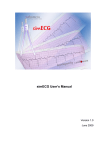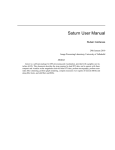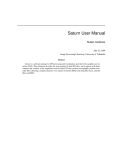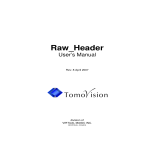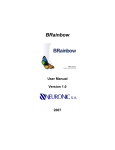Download "user manual"
Transcript
Software Requirements Specification for A mesh to mesh or mesh to image manual fusion tool Version 1.0 Deliverable D7.1 INRIA Virtual Physiological Human Project Table of Contents 1. Introduction ..................................................................................................................... 3 1.1 Purpose....................................................................................................................... 3 1.2 Scope .......................................................................................................................... 3 1.3 Definitions, acronyms and abbreviations .................................................................... 3 1.4 References.................................................................................................................. 3 1.5 Overview ..................................................................................................................... 3 2. Overall description.......................................................................................................... 4 2.1 Product perspective .................................................................................................... 4 2.2 Product functions ........................................................................................................ 4 2.3 User characteristics .................................................................................................... 4 2.4 Operating environment ............................................................................................... 4 2.5 Design and implementation constraints...................................................................... 4 2.6 User documentation.................................................................................................... 5 3. Specific requirements..................................................................................................... 5 3.1 External interfaces ...................................................................................................... 5 3.2 Functions..................................................................................................................... 5 3.2.1 Open .................................................................................................................... 5 3.2.2 Close.................................................................................................................... 6 3.2.3 Save..................................................................................................................... 6 3.2.4 Visualisation......................................................................................................... 6 3.2.5 Selection .............................................................................................................. 6 3.2.6 Fusion .................................................................................................................. 6 3.3 Performance requirements ......................................................................................... 7 3.4 Software quality requirements .................................................................................... 7 3.5 Other requirements ..................................................................................................... 7 Software Requirements Specifications for a mesh to mesh or mesh to image manual fusion tool 1. Introduction 1.1 Purpose This document includes software requirements for a mesh to mesh or mesh to image manual fusion tool. The purpose of this document is to present a detailed description of the above mentioned fusion tool. It will explain the purpose and features of the system, the interfaces of the system, what the system will do, the constraints under which it must operate and how the system will react to user actions. The intended audiences for this specification include: - Developers: in order to be sure they will develop the project in a way that fulfills the requirements provided in this document. - Users: in order to get familiar with the concept of the project and provide comments and suggestions about the tool. - Advanced end users: in order to know exactly what they have to expect from the tool, right inputs and outputs and responses in error situations. 1.2 Scope This mesh to mesh or mesh to image manual fusion tool is designed to provide a user interface that will allow the user to manually: • Move one of the two data sets. • Select corresponding landmarks/points in both data sets. • Activate the fusion process. The following types of transformation will be used for the registration: • Rigid body. • Affine. 1.3 Definitions, acronyms and abbreviations • • • • FTP: File Transfer Protocol HTTP: HyperText Transfer Protocol VTK: Visualization ToolKit DICOM: Digital Imaging and Communications in Medicine 1.4 References Qt library website: http://www.qtsoftware.com VTK website: http://www.vtk.org/ DICOM homepage: http://medical.nema.org/ 1.5 Overview The remainder of this document is organised as follows: section 2 gives a description of the system with information about the functions that will be provided by the system, operating systems, etc… The third section is then dedicated to the specific requirements such as data format or communication interface. 3 Software Requirements Specifications for a mesh to mesh or mesh to image manual fusion tool 2. Overall description 2.1 Product perspective The mesh to mesh or mesh to image manual fusion tool will be designed as a selfcontained system. In the context of medical imaging, it will enable the user to handle heterogeneous data such as meshes and images at the organ level. 2.2 Product functions The tool will provide the user with the following functions: • Database – Open, Close, Save The user can open existing meshes and images by browsing through local directories. Those data can be closed at any time. The user can save new data generated after the fusion process. • Visualisation The user can visualise the data in a graphical user interface. • Selection The user can select corresponding points in the mesh and image to be processed. • Fusion The user can activate the fusion process by clicking a button in the graphical interface. 2.3 User characteristics The main class of user of this fusion tool is the scientist. It is assumed that the user is familiar with the type of data that is processed. The user must also be able to identify corresponding points in both the image and/or the mesh to be fused. 2.4 Operating environment The mesh to mesh or mesh to image manual fusion tool should run on the following operating systems: - 32-bit MS Windows XP - 32-bit Linux - Mac OS X 2.5 Design and implementation constraints The fusion tool will be written in C++ and the graphical user interface will be designed with Qt library. 4 Software Requirements Specifications for a mesh to mesh or mesh to image manual fusion tool 2.6 User documentation The fusion tool will come with: • An offline user manual. • Floating tooltips integrated to the application. • Online tutorials. 3. Specific requirements 3.1 External interfaces • User interface The user graphical interface will be created through C++ and Qt library. All functionalities will be accessed via mouse clicks: open/close data, select points, activate the fusion process. Data will be visualised in the interface’s main window. Fusion process results will be displayed in a separate window. • Data format The user is required to open data with the following formats: - VTK for meshes. - DICOM for images. After the fusion process the data generated will be saved using the format of the moving data. • Communication interface The fusion tool does not use internet communication interfaces such as ftp or http. • Operations The tool will allow the user to indicate which data set will be used as the reference for the fusion process. The other one will therefore be denoted as the moving data set. 3.2 Functions Here are described the functional requirements for the fundamental actions that must be handled by the system. 3.2.1 Open Purpose Inputs Processing Outputs Allow the user to open a mesh or an image. Click on the “open” button or click “open” in file menu. The system enables the user to browse through its directory to find the file. The system checks whether the file format is handled. If the format is handled, the system opens the file. If not an error message is displayed. The system displays the selected data file. 5 Software Requirements Specifications for a mesh to mesh or mesh to image manual fusion tool 3.2.2 Close Purpose Inputs Processing Outputs Allow the user to close an already open data file. Click on the “close” button or click “close” in file menu. The system first checks that a data file is currently open. If yes the file is closed, if not an error message is displayed. The system closes the data that is being displayed. 3.2.3 Save Purpose Inputs Processing Outputs Allow the user to save the result of the fusion process. Click on the “save” button or click “save” in file menu. The system first checks that a fusion process has been run. If yes the result is saved in a data file with the appropriate format, if not error message is displayed. The system saves the data into a file and refreshes the display if necessary. 3.2.4 Visualisation Purpose Inputs Processing Outputs Allow the user to visualise a mesh or an image. Select the data file to visualise. The system retrieves information from the file to enable a correct display. The system display the data file and allow the user to select points in the mesh or the image. 3.2.5 Selection Purpose Inputs Processing Outputs Allow the user to select corresponding points in the mesh or the image. Click on the mesh or image. The system displays the selected points with colors. Selected points are made visible and fusion process can be activated. 3.2.6 Fusion Purpose Inputs Processing Allow the user to activate the fusion process. Click on the “fusion” button. The system retrieves spatial information 6 Software Requirements Specifications for a mesh to mesh or mesh to image manual fusion tool Outputs from the points that were selected and launches the fusion process. Result of the fusion process is displayed in a separate window: axial, coronal, sagittal, as well as 3D views of the aligned data sets will be displayed. The user will be allowed to refine the fusion process by manually adjusting the position of the moving data if needed. 3.3 Performance requirements A real-time synchronisation of the views must be achieved if one view is being modified by the user, for example during manual refinement of the fusion. 3.4 Software quality requirements The mesh to mesh or mesh to image fusion tool must be designed as a light and selfcontained project so it may be run without being installed. All it must take is unpacking from a zip or tar file. It must be designed via the use of software patterns whenever possible, for robustness and for code clarity to facilitate future maintenance. 3.5 Other requirements It is expected that user feedback will result in requests of increased functionality. 7







